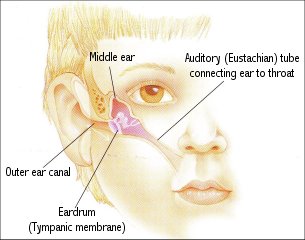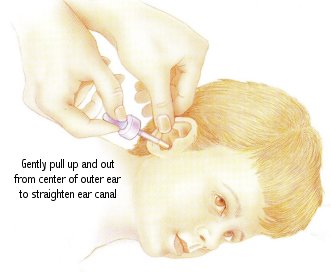How to Use Ear Drops in Children

Correct Technique Important
OTC ear drops are usually given to children to treat swimmer’s ear, pain due to changes in altitude and wax impaction.

How to Administer Ear Drops
Several disorders common in children are treated with medications administered by the use of ear droppers. To be effective, ear drops must be given properly.
Warm the Drops: The first step is to warm the medication. Drops are more comfortable when they are warmed to body temperature. Ear drops should never be hot because they could burn ear tissue or affect the medication. The best way to warm ear drops is to hold the bottle in the palm of your hands or place it in a container of warm water for a minute or two.
Place the Child in the Proper Position: The child should be lying down on his or her side. The ear that is to be treated should be facing up. Depending on the child’s age and his or her ability to hold still, a second person may be needed to hold the child while the first person administers the drops.
Open the Ear Canal: After washing your hands, gently pull the auricle (see illustration) back in order to open the ear canal. Place the prescribed number of drops slowly into the ear, counting carefully as you squeeze the dropper. Some doctors advise placing a clean piece of cotton at the opening of the ear canal. Keep the child in the same position with the ear tilted up for at least two minutes to allow the drops to enter the ear completely.
Repeat the Procedure: This procedure should be repeated whenever the drops are to be administered. If the symptoms do not improve within a day or two, be sure the doctor is notified. If the child complains of pain or burning when the drops are administered, or if redness or swelling occur, stop giving the drops and call the doctor at once.
Reasons to Use Ear Drops: Swimmer’s ear, or otitis externa, is an infection of the ear canal that results from excess moisture or trauma to the skin in the ear. This inflammation results when the protective waxy coating on the skin of the ear canal is removed by wetness, poor wax production or irritation from a finger or object placed in the ear. The symptoms of otitis externa are pain, itching, swelling and redness of the ear canal. Treatment consists of antibiotic and or corticosteroid ear drops given several times each day. Some doctors recommend that an aluminum acetate or acetic acid solution be applied to a piece of cotton and placed into the outer ear to help clean the area so that the antibiotic can work better. In children who develop otitis externa frequently, the use of a dilute acetic acid or alcoholic solution in the ears after each swimming session helps prevent future infections by drying up any excess water in the ear canal. Ear wax impaction is another reason why ear drops are used. The drops can soften excess, hardened wax in a child’s ear so that it can be more easily removed by a professional using an irrigation system or ear syringe. Several nonprescription ear drops for softening ear wax are available, but they should be used only if recommended by a doctor. Some doctors prefer a dilute hydrogen peroxide solution to soften ear wax. These remedies do not remove the wax, and irrigation should be performed only by a professional.Inflammation of the middle ear, or otitis media, is an infection usually treated by oral antibiotics, but ear drops may be used to relieve pressure and congestion m the ear. Follow-up visits to the physician will make sure that an infection has been cleared up. If you have any questions your pharmacist will be able to help you.
![]()
![]()